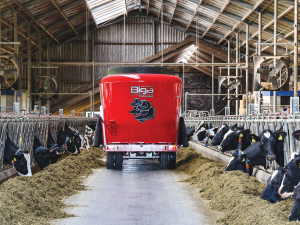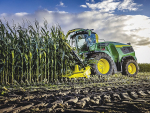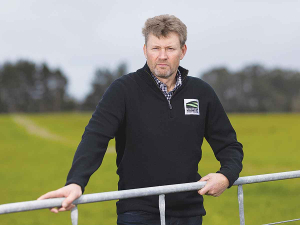While New Zealand dairy production is centred around ‘milk from grass’, over the last decade or so, many operators have found that mixer wagons can play an important part in maintaining, or indeed increasing production, particularly in periods of limited grass growth or drought.
Peecon mixer wagons are imported by FarmShop, based at Kaiwaka in Northland, who operate a direct sell model, rather than the more traditional importer/dealer/customer sales chain.
Manufactured in Holland for the last 25 years, Peecon has a unique shape to its mixer tubs, said to counter “belching” – where material tries to rise and spill over the walls. This is countered by an inwardly curved upper tub wall around the upper edges of the tub, which pushes material, particularly bales, back towards the centre of the machine and onto the auger assemblies.
Constructed using a 25mm thick hopper base plate and 8mm thick hopper walls, the auger assembly is manufactured from 17mm thick, cold-pressed steel, that is not compromised by any heat during construction. Said to feature a unique double-action, the auger system incorporates a slim centre shaft, that works in combination with the auger flights, that in turn carry 14 serrated born steel cutting blades, that are claimed to reduce power requirements and cut mixing times by up to 50%.
In addition, the sweeper assembly at the base of the auger serves to distribute any lower volume ingredients throughout the mix, while also ensuring the hopper is cleaned out completely at discharge.
The drivetrain of the Peecon mixers features a planetary drive layout and maintenance-free bearings, covered by a five-year warranty, with the mixing augers covered by a lifetime guarantee.
The weighing system integrates directly with the farm office PC, offering the ability to record individual mixes and monitor feed inputs against milk output as the season progresses. With ease of use in mind, an optional link to an auxiliary screen in the tractor or loading shovel can display details of a ration, recording weights and final tallies as they progress.
Currently stocking 14, 18 and 21 cubic metre machines, FarmShop notes that bespoke or customised machines can be indented from the manufacturer, typically over a 6 to 8-month period. The importer also suggests that most farmers would typically want to load a mixer wagon once per day/feed, so this will generally determine the size of mixer required, roughly allowing one cubic metre of mixed ration per 20 cows.


















